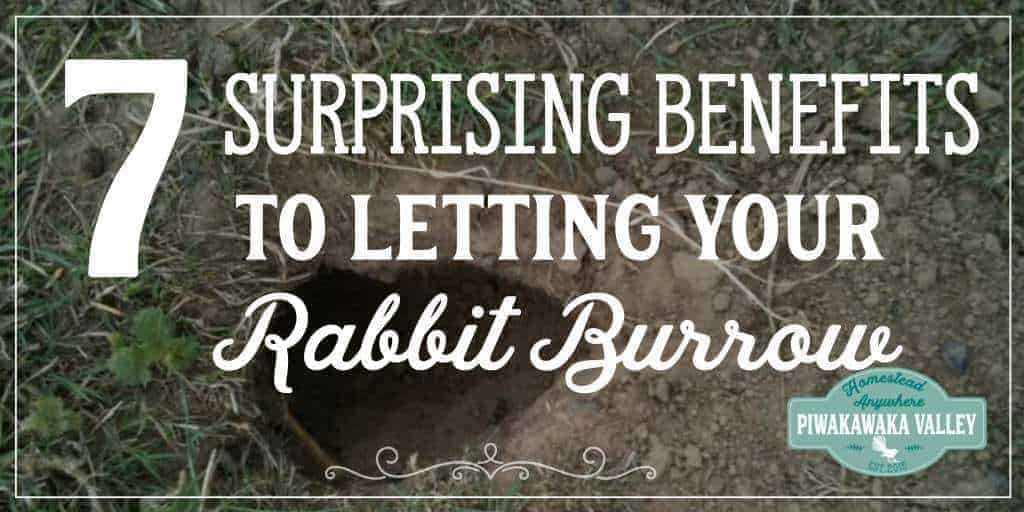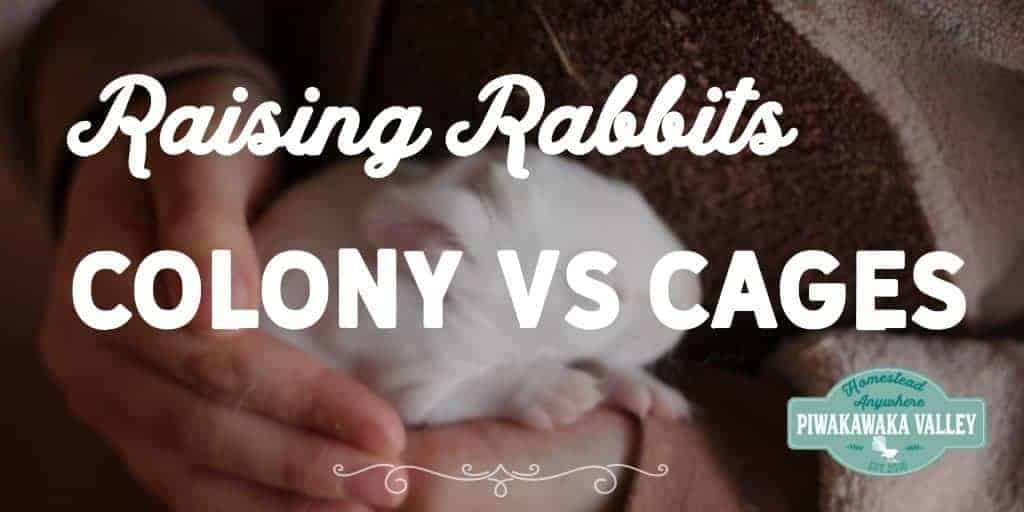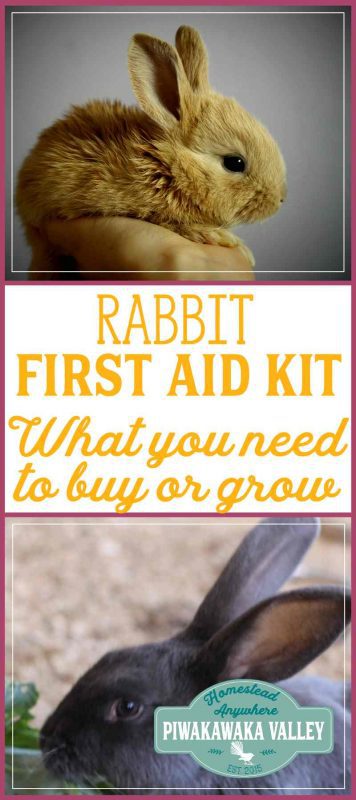This post was most recently updated on July 27th, 2021
Having a rabbit first aid kit set up and in a cupboard ready to go reduces a lot of stress when you are dealing with a sick or injured animal as everything you need is there together.
Please read: This information is provided for educational purposes only and is not intended to treat, diagnose or prevent any disease. We encourage you to make your own health care decisions in partnership with a qualified health care professional.
This post contains affiliate links, this means at no extra cost to you, we make a commission from sales. Please read our Disclosure Statement
I suggest you assemble these things and create a rabbit first aid kit and keep it somewhere handy. This isn’t just a first aid kit for rabbits, you can use these things for most animal situations, and humans too.
While I endorse the use of a vet when it is needed, there are something that either need attended to immediately, are simple to fix at home or just need sorted until slaughter time. There are sometimes times where there simply is no vet around to help.
Disclaimer:
The advice and statements on this blog have not been evaluated by the Food & Drug Administration. I am not a doctor nor a vet – any information on this blog is not intended to diagnose, treat, cure, or prevent any disease. As always please run things past your health professional first.
Tips for putting together a rabbit first aid kit
One of the important additions to your rabbit first aid kit is the phone number of your local vet! Tape it to the top of your first aid box so you don’t have to look it up in an emergency.
Remember to store your first aid kits somewhere that you will remember where they are, but out of the reach of children or other animals.
We keep our first aid/animal emergency kits in a plastic box like this one.
Want to know all about raising rabbits in a colony?
Check out our very own book here:
Available on Kindle and in paperback or from our store
What You Need For A Rabbit First Aid Kit
If you really want to know how to use natural remedies in your everyday life – my friends at the Herbal Academy have a wonderful, affordable beginners course that you really should check out here.
Antiseptic Hand Soap or alcohol
Antiseptic Hand Soap or alcohol gel for washing hands before and after procedures/handling sick animals. If you don’t have this a good scrub with soap and water and a dousing of disinfectant will suffice.
RELATED: Rabbit diseases guide
Baby Food
Baby Food – Keep a can of pure pumpkin or fruit baby puree on hand for helping feed sick rabbits or convincing them to take their medicine.
Baby bottom balm
Baby bottom balm/skin salve: Get a plain, non-zinc based product. Use on scrapes and rashes to keep air and infection out and to keep the wound bed moist to aid healing.
Bandages
Bandages: A selection of gauze, medical tape and crepe bandages. If you can get your hands on some vet bandages that are stretchy but stick to themselves is helpful, they stay on longer.
Bromelain
Bromelain: Also papaya tablets or pineapple juice. Helps to dissolve hairballs. Don’t give in situations where gut stasis has set in, use every other day as a preventative during moulting season.
RELATED: What to do with a sick rabbit
Colloidal Silver
Colloidal Silver: is a powerful, natural antibiotic. It is the most usable form of the most effective disease, germ, virus and fungal killers known.
Colloidal Silver has been found to be both a remedy and a prevention for colds, flu, all infections and all fermentation due to any bacteria, fungus or virus, especially staph, and strep, which are often found in disease conditions. Also, it has been reported to rapidly subdue inflammation and promote faster healing.
Cotton Balls
Cotton Balls/ Cotton Swabs/Gauze: For wiping/cleaning wounds or eyes.
Cornstarch
Cornstarch: For absorbing moisture – help cleaning poopy bottoms. To stop bleeding of the nails when cut too short
Eye Droppers
Eye Dropper: For giving medicine or sugar syrup to weak animals
Flea comb
Flea Comb: For obvious reasons.
Heat Pad
Heat Pads: Useful to heat cold babies or adults who have been chilled or are in shock. Wrap in a towel before use. Can use a hot water bottle filled with hot not boiling water.
Honey: Is an antibacterial, antiviral and antifungal and can be applied topically to wounds to aid healing. It can be mixed with water to give weak animals some energy.
Hydrogen Peroxide
Hydrogen Peroxide 3%: Can be used to initially wash down wounds and remove debris, might be helpful as a chemical debrider but not effective at reducing bacteria counts and when used daily can disturb the healing of the wound bed. (1)
Infant Gas Drops
Infant Gas Drops: Can be given at first suspicion of bloat.
Iodine or Betadine
Iodine: Can be used to wipe around wounds/abscess before treatment/lancing. Can be diluted and used to flush wounds that appear infected.
Lubricant
KY Jelly: For use with rectal thermometer
Mineral Oil
Mineral Oil/Baby Oil: Used to treat ear mites – Treat for the first 2 days than every other day for 14 days after this, 2 times a week for the next 2 weeks ear mites have a 28 day life cycle so you must treat up to the 28 days to make sure all the mites are killed.
Nail Clippers
Nail Clippers: To trim nails and overgrown teeth.
Neomycin
Neomycin Ophthalmic: To treat eye infections/conjunctivitis
Probiotics
Pro-biotic: Helps encourage good bacteria, especially after antibiotics or during hand feeding.
Pedialyte/electrolytes
Pedialyte: To give dehydrated animals.
Rectal Thermometer
Rectal Thermometer: Digital is easiest. A healthy rabbit is 100.5-103.5F (38-39.7C)
Rubbing Alcohol
Rubbing Alcohol: To sterilise scissors/tweezers etc.
Saline
Saline: Sterile medical saline can be given subcutaneously to treat dehydration. Clean but non-sterile saline can be made with one cup of boiled water and 0.5 tsp of table salt. This can be used to wash eyes and wounds.
Scalpel
Scalpel: To lance abscesses.
Sharp Scissors
Scissors: To cut things – try and get ones with rounded tips
Stytpic Powder
Styptic Powder – to stop bleeding of the nails when they are cut too short – Not to be used on the skin. Can use Cornstarch.
Superglue
Superglue: To glue wounds closed instead of stitches. You may need to leave a small opening at the lower end of large injuries to allow the wound to drain, and you can flush saline through to keep it clean.
Syringes
Syringe: To administer oral medication or food/water. Can be used to flush wounds under pressure to remove debris/slough.
Tea Tree Oil
Tea Tree Oil/melaleuca: A natural antifungal, antiviral, antibacterial – very strong, dilute before use. Add 1-2 drops to 1T honey and use a salve for wounds or fungal infections.
Towels
Towels: Old towels to dry wet rabbits, wrap heat pads and help hold rabbits during treatment.
Tweezers
Tweezers: To help remove bot flies, maggots, debris.
Vinegar
Vinegar: To wash down cages as a mild steriliser. Can use diluted bleach or disinfect instead but this will need left to sit for a while then rinsed well as it is not safe for rabbits to eat.
Herbal Remedies You Can Grow for your Rabbit First Aid Kit
Herbal remedies are great to add to your rabbit’s diet to keep them healthy. They are also easy to grow or find in the wild. Keep them on hand in the garden, or dry them and add them to your rabbit first aid kit. Read more here about the uses of specific plants for certain ailments.
Birch
Blackberry
Blue Cohosh
Borage
Chamomile
Chickweed
Coltsfoot
Comfrey
Dandelion
Echinacea
Garlic
Goats Rue
Lavender
Lemon Balm
Licorice
Marjoram
Milk Thistle
Mint
Nettle
Parsley
Plantain
Raspberry
Rosemary
Sage
Shepherd Purse
Strawberry
Thyme
Willow
Please Pin for later and share with your friends!
Want to know all about raising rabbits in a colony?
Check out our very own book here:
Available on Kindle and in paperback or from our store









